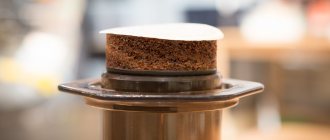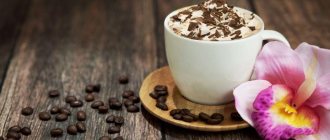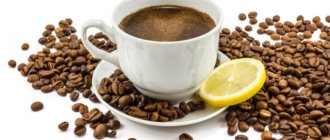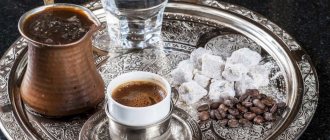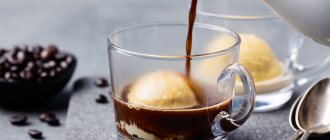Etymology and meaning of the word "espresso"
Russian speakers make the mistake of considering the name “espresso” coffee as the result of a quick process. In the concept of this group of people, the name comes from “express”, derived from the Latin “expressus”. Which means enhanced, fast. The English version offers a translation: “expressus” - a ship or train designed for traveling long distances at high speed. Hence the attitude to the name of the type of coffee as “expresso”, that is, it means something urgent, provided instantly.
Rules for making espresso
Classic espresso differs from other types of coffee in the absence of impurities: milk, cream, alcoholic beverages, spices. By adding these ingredients in various proportions to espresso, you can get several dozen other coffee drinks.
Characteristics of espresso (table)
| Bean varieties | A mixture of several varieties of Arabica, possibly adding a small amount of Robusta |
| Roasting degree | From medium (Full City or Viennese) to dark (Italian or French). The darker the roast, the more bitterness the taste and the less sourness. |
| Grinding | Fine or medium espresso |
| Coffee machine pressure | In the espresso chamber - at least 9 bar, pump operating pressure - at least 15 bar |
| Group water temperature | For medium roast coffee – from +91 to +93 °C, for dark roasted coffee – from +88 to +91 °C |
| Ready coffee temperature | At the outlet of the holder spout - +88 ± 2 °C, in the cup - +67 ± 3 °C |
| Cooking duration, seconds | 25–30, depending on the coffee maker model |
| Portion output volume, ml | 25–30 (including foam) |
| Caffeine content (strength) | 50–68 mg (per serving) |
| Recommended intake (servings per day) | 1-3 |
| Maximum permissible norm (servings per day) | 7 |
| Calorie content | 9 kcal per 100 ml, 2.25 kcal per serving |
| Calories with sugar | 21.60 kcal - a serving of coffee with 5 g of sugar (1 sticker) |
Italian coffee connoisseurs believe that the quality of espresso is influenced by 4 factors, which for ease of remembering are called the 4 m rule:
- miscela (mixture) – a well-chosen mixture of grains;
- macinadosatore – grinding;
- maccina – coffee machine;
- mano (hand) – barista skills.
Selecting coffee for espresso
The main advantage of espresso is its full-bodied taste and rich aroma. Arabica has a wonderful aroma, which is why espresso mixtures contain the most of these beans. But if you brew espresso from beans of any one variety, the aroma will be much poorer, “one-sided”, than that of a mixture of different Arabica varieties.
For greater strength, a little robusta is added to such mixtures, which is almost 2 times richer in caffeine. Robusta has one more feature: it produces dense foam.
When buying coffee beans, you need to pay attention to whether there is a foil valve on the package. Only if it is present does the coffee retain its aroma throughout its shelf life.
In specialized stores you can make the mixture yourself, but there they sell loose coffee in paper bags. This coffee retains its aroma for no longer than 2 weeks from the date of purchase.
When purchasing ground coffee in packs, it is important to ensure that it is sealed. After opening the package, it is better not to leave the coffee in the pack, but to pour it into a glass container with a sealed lid. You should do the same with excess self-ground coffee. But after 2-3 weeks of storage, the smell of ground coffee weakens.
The best aroma comes from espresso made from beans ground immediately before preparing the drink. Even if several hours pass between grinding the beans and brewing the coffee, the coffee will have time to become damp and even stale a little.
Ground coffee with aromatic additives is not suitable for making espresso: it is impossible to predict how artificial flavors will behave in an espresso coffee maker.
Grinding coffee for espresso
It is important to know the rules:
- if the grind is too fine, the stream of coffee poured into the cup becomes almost black, and small particles can clog the coffee maker filter;
- When grinding coarsely, the espresso turns out liquid and tasteless.
There is a special fine espresso grind: finer than medium, but coarser than fine. However, you can also use medium grind coffee. Experienced baristas advise using slightly coarser ground coffee in wet weather: this powder absorbs moisture more slowly.
Correct grinding
Choosing a coffee maker
Each model of coffee maker or coffee machine has individual features that are important to study.
Signs of a good espresso coffee maker:
- stainless steel holder. No matter how high-quality the plastic holder is, when heated it adds unpleasant chemical odors to the aroma of espresso;
- the optimal pressure in the espresso chamber is 9 bar, the pump should provide a pressure of 15 bar, you should not buy coffee makers with lower values of these parameters;
- the water in the boiler should be heated to a temperature from +87 to +95 °C. At a lower temperature, the coffee turns out to be liquid and insufficiently extracted; at a higher temperature, there are hints of burning in the drink.
Tamping the coffee in the holder with a tamper is a mandatory step.
Preparing to brew espresso
To make espresso rich and aromatic, you need to take into account some subtleties:
- Even if you want to make the espresso stronger, you cannot pour too much coffee into the holder: in this case, it will be difficult to compact it with a tamper. If the ground coffee is not pressed evenly, water will flow through areas of less density. As a result, the drink will be liquid;
- It is important to choose the right tamper. Preference should be given to stainless steel tampers: aluminum and plastic ones are too fragile. The flat base tamper is suitable for both single and double holders. But Americans prefer to use tampers with a convex (spherical) base for double holders: it compacts the center of the tablet most intensively, and presses the edges against the walls of the portafilter. As a result, the surface area of the particles washed by water increases;
- ground coffee for a carob coffee maker is compressed, applying a force of 19–20 kg to the tamper;
- If you use too hard water, the coffee turns out bland and unflavoured; if you use distilled water, the taste deteriorates and the strength decreases. For espresso you need moderately soft, filtered or bottled water (mineralization – 75–250 mg/l, optimally – 150 mg/l) without chlorine ions;
- the finished coffee should be poured into a preheated cup, preferably a ceramic one;
- espresso cannot be poured from one container to another;
- the foam should be uniform in color. White spots are a sign of excess caffeine in a serving.
You can't make espresso without a coffee machine
Origin of the word "espresso"
The term “espresso” originates from Italy, from It. Esprimere, which translates as “pressed”, cooked under pressure.
So this is the name of the method. It is used to prepare the drink beloved by Italians. Also, the literal translation means “expressed,” and this is true, since “espresso” has a bright, rather tart taste and aroma.
The meaning of “espresso” in the dictionary of foreign words is described as a strong, invigorating drink made using a special coffee machine under pressure. The second meaning is a cafe where coffee is prepared. Wikipedia considers this name as a drink prepared by pushing water, the temperature of the liquid is about 90 degrees, and under pressure, through a certain filter with ground coffee beans.
History of espresso coffee
Strong black coffee is the eternal love of all residents of the Mediterranean coast. But until the 20th century, the drink was prepared only in cezves (Turks), and coffee shop visitors had to wait too long for their order. Therefore, when the Milanese engineer Luigi Bezzera invented the coffee machine in 1901, it immediately became clear that the device had a great future. Already in 1903, entrepreneur Desiderio Pavoni acquired a license and in 1905 began producing Pavoni coffee machines.
The world's first coffee machine by Luigi Bezzera
The novelty delighted the public: now it took only half a minute to prepare coffee, so the name espresso was well deserved. Even before the war, the fashion for coffee machines spread to Italy and France. In 1927, the first coffee machine appeared in one of the bars in New York.
But there were some dissatisfied people. The fact is that in the model of coffee machine invented by Bezzera, the particles of ground coffee overheated, the taste of espresso lost its sophistication, and the tones of burnt beans were felt in it.
The shortcoming was corrected by Milanese bartender Achille Gaggia, who proposed a completely different technology. In the Gaggia semi-automatic coffee maker, pressure was created by a stream of hot water supplied under strong pressure. Since the water temperature in such a coffee maker is below +100 °C, the aroma of the drink is fully revealed, but there is no smell of burnt beans.
The economic situation in Italy after the war was extremely difficult, which is why many residents emigrated to English-speaking countries: the USA, Canada, Australia. In cafes and bars that Italian emigrants opened in foreign lands, they always served espresso coffee. As a result, already in the mid-60s of the last century, the drink gained popularity on all continents. It is loved even in conservative Asian countries, although there they drink espresso chilled, mixed with ice.
Why is there confusion with the words "express" and "espresso"?
Philologists explain the resulting confusion with the words “express” and “espresso” by the fact that people are influenced by an erroneous “etymology”, according to which the name coffee means a quickly prepared aromatic drink. According to experts at the Institute of Philology, this occurs as a result of the substitution of concepts, when a closer meaning of a word is assigned to another, similar in sound and spelling.
But the word forms “espresso” and “expresso” are not close in meaning or related. These are completely different units with their own lexical meaning and pronunciation. And calling coffee “expresso” in this case is indecent.
Classic espresso recipe
Ingredients:
- ground coffee – 7 grams;
- water – 30 ml;
- sugar - to taste.
Cooking technology
1. Turn on the coffee maker and wait for the ready indicator to light up.
2. If the coffee machine is equipped with a built-in coffee grinder, put a tablespoon of beans into it. For a carob coffee maker, pour 1 measuring container or 2 teaspoons with a small heap of ground coffee into the carob.
3. Press the coffee in a holder with a tamper (for a carob coffee maker).
4. Install the holder into the coffee maker.
5. Place a clean, warm cup in the drip tray. Cooking time – 25–30 seconds.
6. Add sugar to taste.
You can tell if espresso is made correctly by the foam
Sometimes on the Internet there are recipes for espresso at home, prepared in Turk. However, this drink is a variant of Turkish coffee and is completely different from classic espresso. Real espresso coffee can only be brewed in a special coffee maker.
Example sentences
- Every morning she drank her favorite espresso and went to work.
- “I’d like a cup of espresso and a piece of cake, please,” was heard in the cafe at the same time during the day.
- “Espresso, evening, stars and a loved one nearby - nothing more is needed for happiness!” - the girl thought.
- During a break, already in the office, a hastily drunk glass of espresso replaced both breakfast and lunch.
- The evening express rushes towards great discoveries and secrets.
- The new Express train operates at night, departing at 24:00 Moscow time from Leningradsky Station.
- Our cafe offers express delivery from 9 am.
How to serve and drink espresso
Espresso is served within 1–1.5 minutes after preparation, in special small coffee cups or thick-walled demitasse cups. Along with coffee, be sure to place on the table a glass of still water at room temperature and a stick of sugar (5 g) or a sugar bowl. Sugar is added to the finished drink (optional).
Before drinking coffee, you need to take a sip of water to cleanse your receptors. Espresso must be drunk as quickly as possible, otherwise its taste and aroma will deteriorate.
The correct way to serve espresso is with a glass of water.
You can have espresso as a snack:
- chocolate (bitter or with pepper is especially good);
- fruits;
- hard cheese.
- Meats, fish, vegetables, beer and wine do not go well with espresso.
Misspelling of the word "espresso"
The spelling of the word "expresso" is considered misspelled. The acceptable and correct option is “espresso” without the letter “k”. It is unknown how the rule regarding this lexeme will change in the future, but it is assumed that the spelling "expresso" will be acceptable. So far, these are just speculations and assumptions, which are categorically rejected by linguists and morphologists.
A literate person understands that the only correct decision is to choose the “espresso” option; the letter “k” is absent in this word form.
And the word “express” is used to mean “train” or something “urgent”. The spelling and pronunciation of this lexical unit must be memorized. If you have any difficulties, you need to consult a dictionary.
Espresso: benefits and harms
What effect does coffee have on the body? It is impossible to answer unequivocally, because each of us has individual characteristics of the body and a different state of health. We must not forget about the amount of product consumed, which should be within the acceptable limit. However, there are generally accepted provisions about the dangers and benefits of espresso that are worth paying attention to.
Harm
- Pregnant and lactating women are not recommended to drink such invigorating coffee due to the high caffeine content, which excites the nervous system.
- For people who have digestive problems, drinking a cup of espresso on an empty stomach can cause discomfort, heartburn and even pain.
- Espresso can cause heart palpitations, which is worth keeping in mind for people with heart rhythm problems.
- The slight coloring effect of strong drink can lead to darkening of tooth enamel.
Benefit
- Some researchers believe that coffee is a preventive measure against cancer.
- Espresso helps to invigorate you due to caffeine, which provokes the release of adrenaline.
- After eating, the drink can improve the digestion of food.
- Researchers from South America claim that men who drink espresso in the morning increase potency and libido. The opposite effect awaits a coffee lover if he allows himself a cup in the evening.
- Drinking this energizing drink between meals reduces appetite. But don’t get carried away and replace a full lunch or dinner; it’s better to treat yourself to a coffee delicacy instead of a hearty snack or afternoon snack.
- The boost of caffeine promotes increased brain activity and improves mood.
View this post on Instagram
Publication from Coffee House
